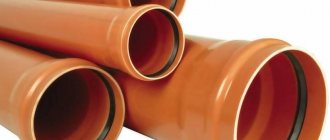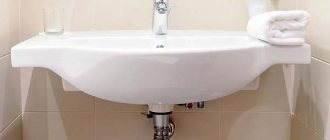Why do we need inspection hatches for the bathroom and toilet? When arranging these premises, it is impossible to do without connecting communications. Of course, the bathtub and toilet are places for individual use, but exposed pipes and hanging wiring “hurt” the eye and significantly spoil the interior. Therefore, all plumbing connections are usually hidden under the facing material. It is impossible to completely block access to communications: you need to regularly write off meter readings and carry out maintenance. This opportunity is provided by plumbing hatches for the bathroom and toilet, the dimensions of which provide unhindered access to pipes and meters. In fact, these are decorative doors that do not stand out from the overall interior of the bathroom. The dimensions of these elements are standard, only the design options differ. Let us examine in detail all the features of these plumbing products.
Typology
Communication hatches are distinguished by the method of opening, design features, and type of installation.
Opening methods:
- swing;
- push;
- folding;
- sliding
Design features:
- reinforced;
- two-door;
- under tiles (cladding).
Installation types:
- ceiling;
- wall;
- floor
Manufacturing materials:
- aluminum;
- plastic;
- steel.
Convenient sliding
When selecting inspection hatches for communications in the bathroom, it is necessary to assess the amount of space for installing and opening the hatch. If it is not enough for the swing of the swing door, give preference to a sliding design. It significantly saves space, when closed it coincides with the installation plane, and can be lined with any material used in the room (ceramic tiles, stone, drywall, painting).
Moving to the side, the structure does not sag on its hinges, which allows for any type of work. A line of standard sizes of hatches is produced, they can be purchased at any hardware store, but if an exclusive approach is needed, then this will not be a problem - many companies provide custom-made manufacturing and installation services.
Dimensions
Plumbing hatches come in square or rectangular shapes. The dimensions are usually standard and do not depend on the design features and materials used.
Typical sizes look like this:
- 100x100 mm.
- 150x150 mm.
- 150x200 mm.
- 200x200 mm.
- 200x250 mm.
- 200x300 mm.
- 250x300 mm.
- 250x400 mm.
- 300x300 mm.
- 300x400 mm.
- 400x500 mm.
- 400x600 mm.
The planting depth for all products is 35 millimeters.
Considering that the given dimensions may not meet the necessary requirements, some companies manufacture plumbing hatches to individual sizes. For example, for the installation of a large communication center, where repair and maintenance work is carried out by two specialists. Production times vary from 3 to 6 days, the cost of such products differs significantly from standard models.
USEFUL INFORMATION: Installing forced ventilation in the bathroom: if it blows, if it doesn’t work, how to improve
Traditional solution
The hinged door design is the most common, but it requires a certain amount of space to open, which is not always convenient in small bathrooms. Plumbing hatches to the toilet can have dimensions corresponding to a standard plastic product. And this is not always convenient. Therefore, a plastic plumbing hatch, the price of which is low, has a line of model sizes, one of which will surely suit you.
To gain access to the entire length of communications in the apartment and at the same time not to clutter up the volume of the toilet room with hinged hatch doors, install a roller blind. This is the most expensive type of communication hatch, but it is one of the most durable. Plumbing hatches to the toilet can also be made according to a special project.
Hygienic simplicity
A plastic plumbing hatch, the dimensions and installation of which are standard, is easy to install, is resistant to a humid environment, is affordable and is always on sale. The lightness of the material from which it is made allows it to be used for installation on walls and ceilings. The advantages of a plastic hatch include its ventilation qualities, the ability to install it yourself and its affordable cost.
You should not place a plastic hatch in a place with direct water ingress; a leaky door will not protect the plumbing box from dampness, which can lead to structural destruction, the spread of fungus and the emergence of pathogenic organisms. Its drawback is more of an aesthetic nature, but the situation can be improved by painting the door and frame in a color that is consistent with the rest of the color scheme of the room. The plastic plumbing hatch has a minimum size of 10 x 10 centimeters and a maximum of 40 x 60 centimeters, which fully covers the needs of access to pipes.
The approximate cost and popular sizes are shown in the table:
| Size, mm | Material, color | Average price, rub. |
| 100 x 100 | plastic, white | 140,00 |
| 150 x 150 | plastic, white | 160,00 |
| 150 x 200 | plastic, white | 180,00 |
| 200 x 200 | plastic, white | 200,00 |
| 200 x 250 | plastic, white | 220,00 |
| 200 x 300 | plastic, white | 240,00 |
| 250 x 300 | plastic, white | 280,00 |
| 250 x 400 | plastic, white | 300,00 |
| 300 x 300 | plastic, white | 320,00 |
| 400 x 500 | plastic, white | 600,00 |
| 400 x 500 | plastic, white | 600,00 |
| 400 x 600 | plastic, white | 870,00 |
Purpose of inspection hatches in bathrooms
A distinctive feature of modern bathrooms and toilets is a thoughtful design, as a result of which the aesthetic side of the finish comes to the fore. Technical devices that provide comfortable bathing or ease of use of the toilet are hidden behind thin structures made of plastic or plasterboard.
Constant maintenance of pipes is not required, but periodically there is a need to use shut-off valves. For example, in order to cut off the water supply to the kitchen in connection with replacing the faucet, you need to turn off a certain tap.
Devices resembling doors or hatches are necessary for servicing metering devices that are hidden behind partitions. By moving the damper or opening the door, you can quickly take readings from the hot and cold water meters
If the bathroom is completely lined with plastic or tiles, more hatches will be required. Suppose one of the nodes that requires constant access is the location where the water seal for the bathtub is installed. If the protective screen is made blank, then it will have to be dismantled every time there is a blockage in the pipe or a leak occurs at the junction of the siphon parts.
We can conclude that any components and devices that require regular checking should be freely accessible. And when the premises are completely covered with tiles or plastic, this can only be achieved with the help of technical hatches.
Decor with a secret
A plumbing hatch for tiles is a metal frame on which a door is mounted, followed by decoration. The main advantage of this design is its invisibility. The hatch structure is immersed in a box, and the hatch cover is finished with the same materials as the walls. The reinforced design of the frame and door can easily withstand ceramic tiles, natural stone, mosaics and other “weighty” materials. Hidden installation eliminates any differences between the hatch and the general plane of the wall or floor.
Hidden inspection hatches can be opened in any way, it all depends on your desires. The lightweight design is a completely removable door; in this case, the cover is simply removed, allowing access to the plumbing fittings. When closed, it is secured with a magnetic lock.
An additional advantage of hidden inspection hatches is the push-pull opening mechanism. In this case, the presence of the door is not indicated by any handle, and there is also no need to have a suction cup on hand as a handle. With a little effort on your part, the roller-pressure lock pushes the door out, and it also closes by simply gently pressing the corner where the mechanism is installed. With high-quality installation of the decor on the door, the hatch is invisible and forms a single whole with the wall.
Installation features
Product installation
The weight of the plastic structure is small, so it can be installed in the opening of not only main walls, but also light structures made of plasterboard, wood, and plastic. The frame is secured with self-tapping screws or fixed with liquid nails. Some people use silicone, but this option does not guarantee a strong connection.
Required tools:
- jigsaw;
- drill, hammer and screwdriver (screwdriver) or construction gun, depending on the chosen fastening method;
- roulette;
- level;
- pencil or marker for marking;
- construction knife.
The overhead plastic inspection hatch must be installed so that there are no noticeable gaps between the frame and the wall:
- Measure the product.
- Apply a contour corresponding to the size of the plastic hatch on the plasterboard box.
- Cut a hole with a jigsaw (you can make the opening 1-2 mm larger).
- The walls are finished, for example, tiled and the seams are grouted.
- Place the frame in the opening and secure it with self-tapping screws.
- If mounting holes are not provided, fix them with glue or foam. The composition is applied to the inner surface of the platband or end frame. Insert the frame into the hole and press it against the wall surface. Immediately wipe off any excess compound with a dry cloth.
- Install a lock if necessary.
- If necessary, paint the hatch. Waiting for the paint to dry.
The plastic hatch under the tiles is installed in a different way. The hidden design is called LSIS. It is produced by VS Group.
It is not necessary to buy a hatch that exactly fits the hole in the wall. You can purchase a slightly larger one, because it is more convenient to cut it on three sides, adjusting it to size:
- The lower and upper guides are installed in the prepared opening with glue. The corner shelf of the guides allows for easy and correct installation.
- The guides are leveled.
- They try on the manhole cover and adjust the dimensions to fit the location.
- Make markings for installing the lock.
- From the side where the lock is installed, the stiffening ribs are cut down 1.5-2 cm and the surface is cleaned with a construction knife.
- Install so that the groove in the lower part of the shield fits into the lower guide, and the upper part of the shield, where the bracket with the locking mechanism was previously installed, is snapped into the upper guide box.
- Glue is applied pointwise to the finishing tile and glued to the installed board. Align the finish to the general plane of the wall.
- After the glue has completely hardened, the seam around the perimeter of the LSIS is filled with colored sealant.
- After the sealant has dried, use a blade or wallpaper knife to trim one side of the sealant seam from the side of the main wall.
- The sealant, in addition to its decorative function, serves as a sealant.
To perform an inspection, the hatch is opened using a suction cup or by pressing, depending on the type of lock installed.
Floor without blemish
Additional requirements are imposed on the design of floor hatches; strengthening of the load-bearing parts and the cover requires attention. These structures must withstand the load from heavy objects that may stand on the hatch during operation. Floor hatches have a hidden design and a massive box. The installation of the hatch box is carried out during the installation of the final floor screed. The door should not be higher or lower than the floor level. Such hatches are installed for access to pipes, as a hidden entrance to the basement. The material for making hatches is steel for painting, ceramic tiles or any other decor. The opening mechanism is folding.
When choosing a hatch for access to communications, pay attention to every indicator of quality and comfort of use, ease of operation and manufacturer’s warranties. A plastic plumbing hatch, the size of which suits your needs, is the most popular opportunity to gain access to communications while maintaining the aesthetic perception of the interior.
Useful tips
Arranging a bathroom is quite a complex and painstaking job. Therefore, it is necessary to install plumbing hatches for the bathroom and toilet correctly, so as not to redo the door later, spoiling the lining of the room. We advise you to pay attention to the following nuances:
- When choosing a product, keep in mind that hatches come in horizontal and vertical orientation. Therefore, before purchasing it is necessary to take appropriate measurements.
- Be sure to use a level during installation.
- Considering that the sizes of hatches for bathrooms and toilets differ, small structures can be installed entirely, while large ones are usually disassembled into their component parts.
- When finishing with ceramic tiles, the cladding is done directly under the door, leaving the bottom row for last. This trick will help you avoid distortions and adjust all decorative elements to size.
USEFUL INFORMATION: Using moisture-resistant drywall in the bathroom
These simple tips will help make the hatch in the bathroom or toilet less noticeable without spoiling the overall interior of the bathroom.











